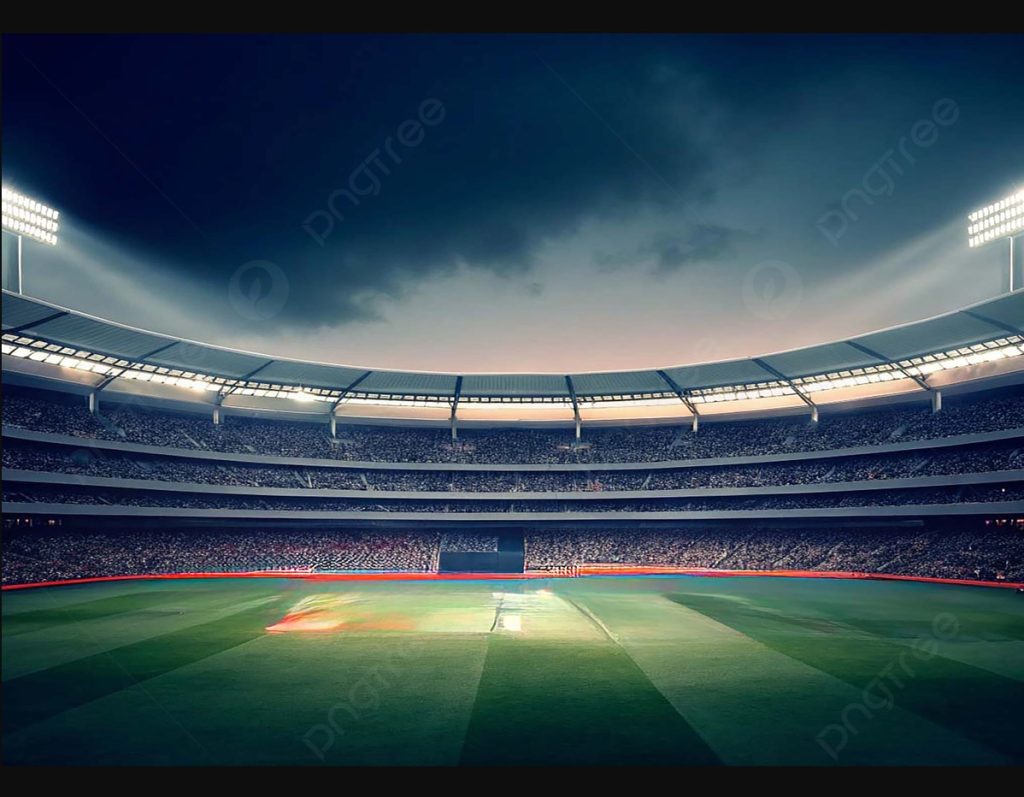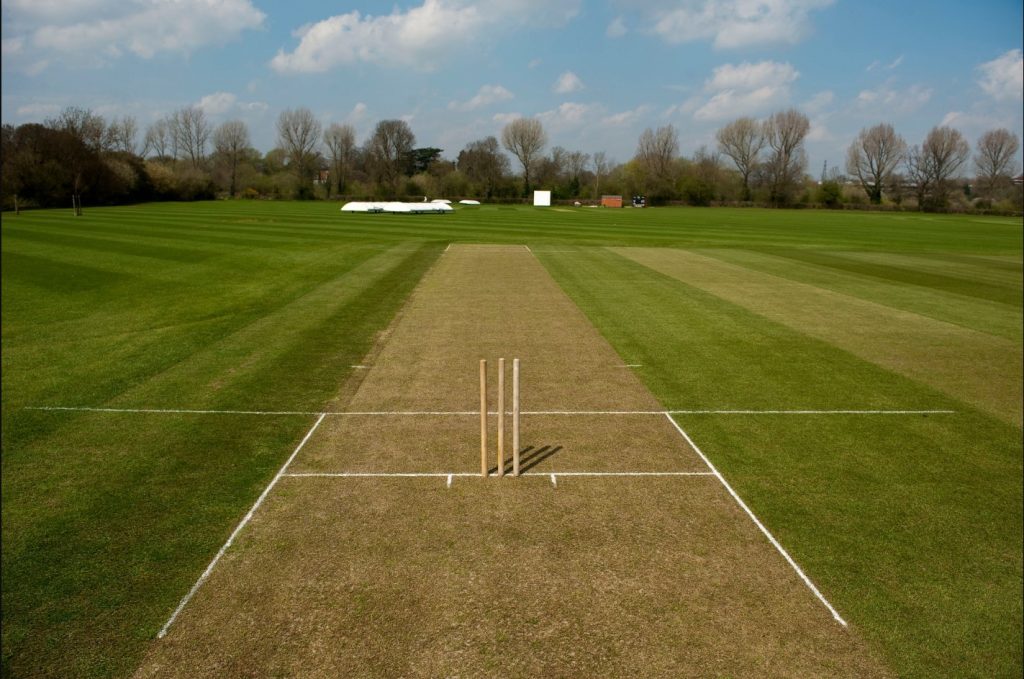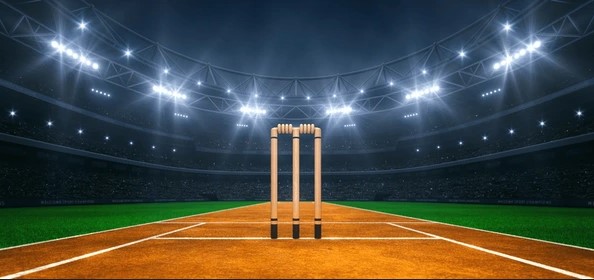Cricket Field: Cricket, a sport beloved by millions around the world, is played on a specific type of field known as a cricket field. Unlike other sports that may take place in a more conventional rectangular or square area, a cricket field has a unique shape and specific dimensions that cater to the nature of the game. This article will explain the components of a cricket field, its dimensions, and its various sections, providing an in-depth understanding of how it supports the game.
The Basic Structure of a Cricket Field

A cricket field consists of two primary parts: the pitch and the outfield.
The Pitch: The pitch is the central strip of land on which the game’s main action occurs. It is a flat, rectangular area of 22 yards (20.12 meters) in length, where the bowler delivers the ball and the batter attempts to hit it.
The Outfield: Surrounding the pitch is the outfield, which is the area where the fielding team positions its players. The outfield can be grassy or covered in a variety of materials, depending on the venue. It is much larger than the pitch and provides space for players to chase balls hit by the batter.
Key Components of a Cricket Field
Let’s explore the various components and sections of a cricket field in more detail:
1. The Boundary
The boundary marks the outermost limits of the playing area. It can be a fence, wall, or a set of ropes and is usually marked in a circular or oval shape, though it may vary depending on the ground’s configuration. The boundary is significant because hitting the ball past it in the air (over the boundary) awards the batter six runs, while hitting the ball along the ground past the boundary awards four runs.
| Type of Boundary | Runs Awarded |
|---|---|
| Over the Boundary (in the air) | 6 |
| Along the Ground | 4 |
2. The Pitch

The pitch is the key area in cricket. It is where most of the action takes place, with the bowler delivering the ball and the batter attempting to strike it. The pitch is 22 yards (20.12 meters) long and 10 feet (3.05 meters) wide. The key features of the pitch include:
The Creases: There are three creases on the pitch:
Bowling Crease: This marks the point where the bowler’s front foot should not cross when delivering the ball.
Popping Crease: This marks the point where the batter must reach to be considered safe, particularly when attempting to run between the wickets.
Return Crease: The return crease runs parallel to the stumps and allows the bowler to take a wider approach when delivering the ball.
| Crease Type | Description |
|---|---|
| Bowling Crease | Marks where the bowler must deliver the ball from |
| Popping Crease | Marks where the batter must reach to be considered safe |
| Return Crease | Runs parallel to stumps and determines the bowler’s run-up |
3. The Stumps and Bails
At each end of the pitch, there are three stumps (vertical wooden poles) placed 9 inches apart. The stumps are topped with bails (small horizontal pieces of wood) that rest on top. The stumps and bails form the wicket, which the bowler aims to hit to dismiss the batter.
| Component | Description |
|---|---|
| Stumps | Three vertical posts forming the wicket |
| Bails | Small horizontal pieces of wood that sit on top of the stumps |
4. The Outfield
The outfield is the grassy area surrounding the pitch. The dimensions of the outfield vary but are usually between 125-150 meters in diameter. In a professional setting, the outfield may be finely maintained to allow for a faster, smoother game. The grass and the surface play a crucial role in the bounce and movement of the ball once it’s hit by the batter.
The fielding team positions its players across the outfield, with some in close positions (close to the pitch) and others spread out towards the boundary. The position of fielders can vary depending on the strategy adopted by the team.

| Outfield Area | Description |
|---|---|
| Inner Circle | Close to the pitch, where the fielders can make quick plays |
| Outer Circle | Further from the pitch, typically for boundary fielders |
5. Fielding Positions
A cricket field is divided into several sections that help organize the fielding positions. The positioning of players depends on the type of delivery, the batter’s strengths, and the bowler’s strategy. Below is a list of common fielding positions and their general locations:
| Fielding Position | Description |
|---|---|
| Slip | Positioned behind the batter on the offside, used for catching edges |
| Gully | Positioned behind slip, to catch balls that might go wide |
| Cover | Positioned in front of the batter on the offside, near the boundary |
| Mid-on | Positioned on the onside, near the boundary |
| Mid-off | Positioned on the offside, near the boundary |
| Fine Leg | Positioned on the onside near the boundary |
| Third Man | Positioned on the offside near the boundary |
| Bowler’s End | Positioned just behind the bowler for backing up throws |
6. The Boundary Rope and Circle

The boundary rope marks the edge of the field and can be either a rope, a fence, or a wall. Surrounding the boundary rope is the fielding circle (or the 30-yard circle), an area within which the fielding team must place a specific number of players during the powerplays in limited-overs cricket.
| Boundary Area | Description |
|---|---|
| Boundary Rope | The outer limit of the field where boundaries are scored |
| Fielding Circle | A 30-yard (27.43 meters) area where fielders must stay within during certain overs |
7. The Pavilion
Located behind the wicketkeeper and bowler, the pavilion serves as the changing area for the players and is also where spectators gather. In many professional grounds, it also contains the media, coaches, and officials’ areas.
Dimensions of a Cricket Field
The dimensions of a cricket field can vary depending on the venue, but there are general standards observed in the sport. The pitch itself has fixed dimensions, but the overall size of the field may differ from one ground to another.
| Area | Typical Dimension |
|---|---|
| Length of Pitch | 22 yards (20.12 meters) |
| Width of Pitch | 10 feet (3.05 meters) |
| Diameter of Field | 125-150 meters from the center of the pitch to the boundary |

A cricket field is not just a large area of land, but a carefully designed playing space that serves to facilitate a highly strategic and dynamic game. Every section of the field, from the pitch to the outfield, plays a critical role in the flow of the game. Understanding the various components and how they contribute to cricket is key to appreciating the sport. With its dimensions, creases, and fielding positions, the cricket field offers a unique playing environment that makes cricket such a fascinating and challenging sport.
